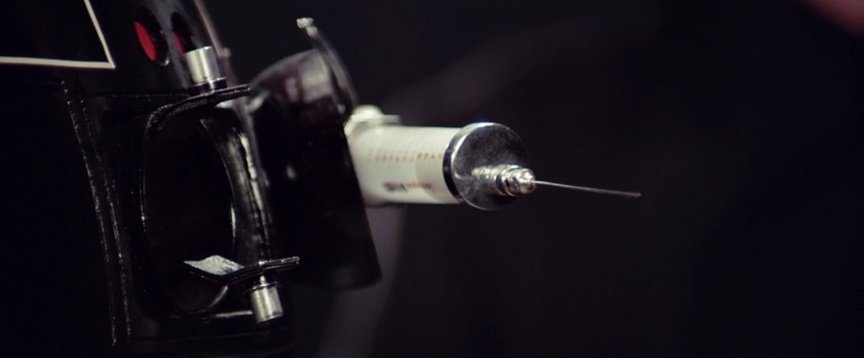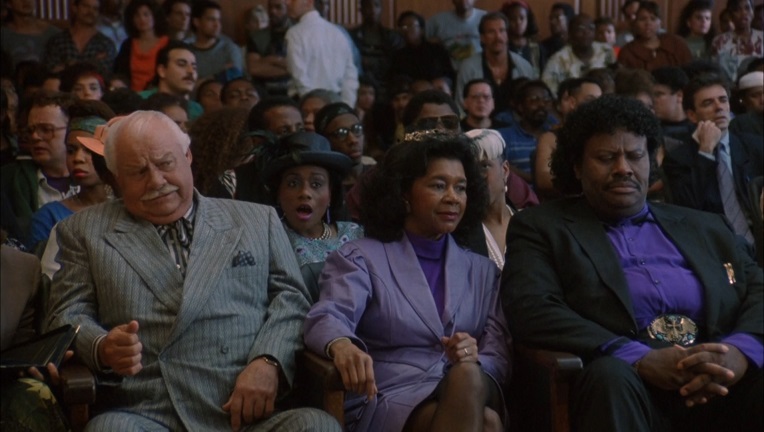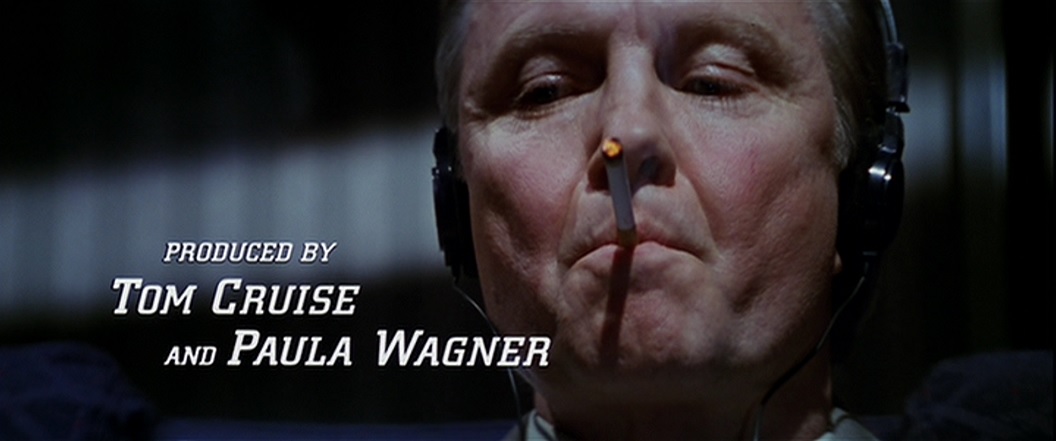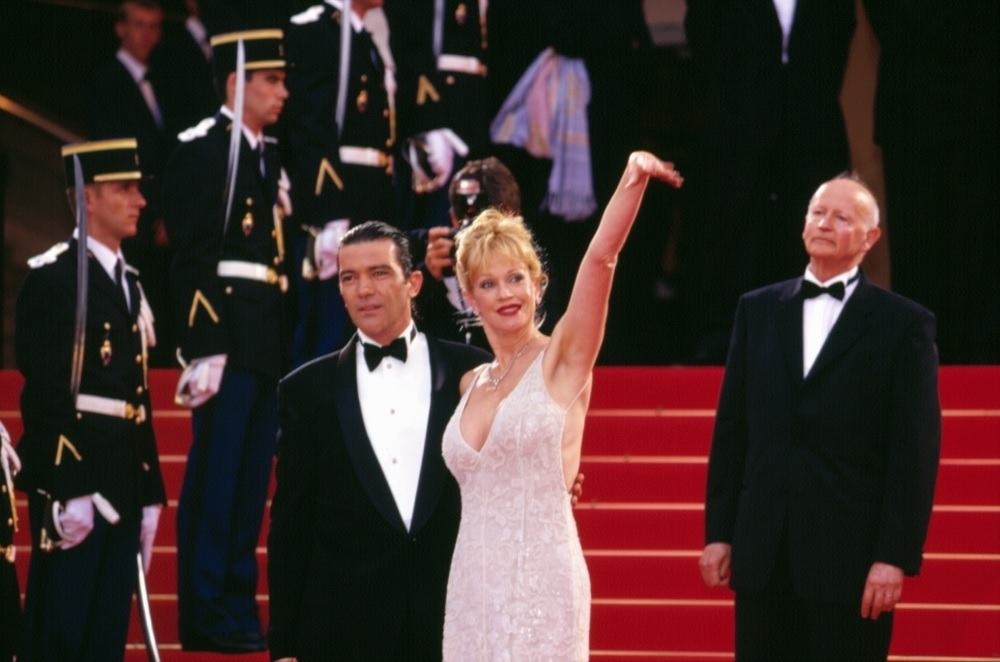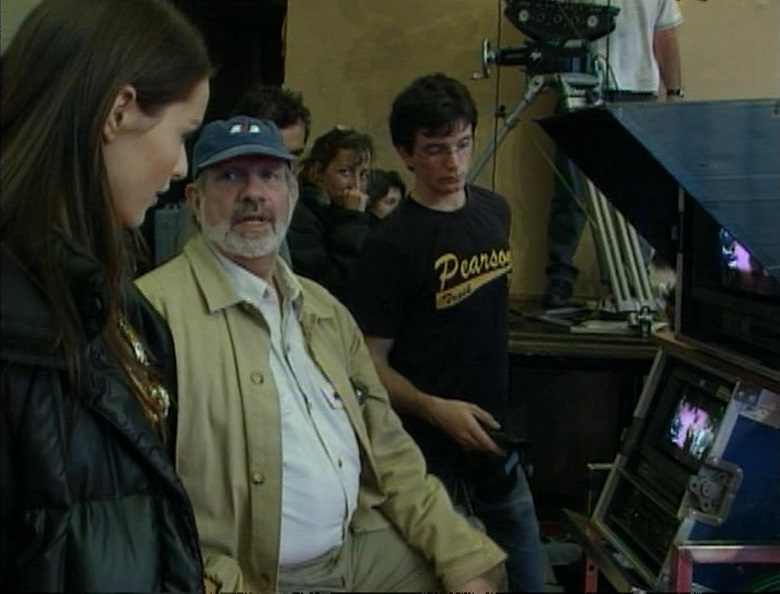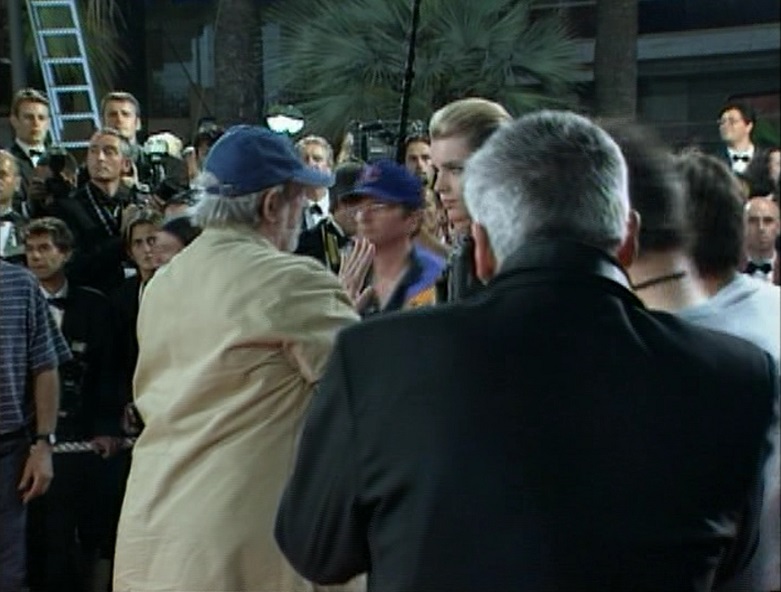VIDEO - TOM CRUISE TALKS 14-HOUR DE PALMA MARATHON
RE-WATCHED & CRASH-STUDIED DE PALMA'S FILMS AFTER MEETING HIM AT SPIELBERG'S HOUSECollider's Adam Chitwood shared a Collider-exclusive preview today of a chat between
Tom Cruise and
Christopher McQuarrie. In the video clip, Cruise talks about how
Steven Spielberg "lived down the street" from him, and how Cruise would go and have dinner with him ("as one does" McQuarrie jokes), and the two would talk about movies.
Tom Cruise: I remember one night I went over and there was Brian De Palma. And so we had dinner. The three of us had dinner at this place up the street. And we were just talking about movies, and there was Brian, and I’d seen all of his films, and I went home that night – you know, Mission was on my mind; I was actually preparing, also, I was prepping Interview With The Vampire at that time, and working on a few other things. And I went home that night and I stayed up for about 14 hours and I just got all of De Palma’s movies and I restudied all of his films. Christopher McQuarrie: For De Palma movies, we're talking about Carrie, Blow Out...
Tom Cruise: Yes.
Christopher McQuarrie: Dressed To Kill...
Tom Cruise: Untouchables...!
Christopher McQuarrie: Untouchables.
Tom Cruise: Okay. And... I just went, "Oh my gosh," that... "he’s gotta direct Mission: Impossible."
MORE 25TH ANNIVERSARY 'MISSION: IMPOSSIBLE' ARTICLES PROLIFERATING AROUND THE WEB... Ryan Parker, The Hollywood Reporter
Tom Cruise Nailed Classic ‘Mission: Impossible’ Stunt on Final Attempt
One of the most iconic shots from the first Mission: Impossible film nearly did not happen because Tom Cruise was having a difficult time pulling it off. In a series of snippet interviews the star did with director-screenwriter Christopher McQuarrie for Paramount’s anniversary Blu-ray of the 1996 film that kick-started the billion-dollar franchise, Crusie explained that he kept falling too far when he was suddenly lowered via a cable into CIA headquarters vault.
Cruise said he was unable to balance fast enough on the cable.
“We were running out of time, and I kept hitting my face and the take didn’t work,” the actor said, explaining he finally asked crew members for British pound coins to put in his shoes as counterweights.“[Director] Brian [De Palma] said, ‘One more and then I am going to have to cut [into the moment] and do it,'” Cruise said. “I said, ‘I can do it.’ And I went down to the floor, and I didn’t touch. I remember thinking, ‘Oh, my gosh. I didn’t touch.’ And I was holding it, holding it, holding it, holding it. And I’m sweating and I’m sweating. And he just keeps rolling.”
Cruise said he realized in that moment that they got the shot and De Palma was now just messing with him. Finally, De Palma began to laugh and called cut.
In another interview section, Cruise said he was stuck in a traffic jam in Japan while marketing another film when he got the pitch call from De Palma for Mission: Impossible.
Bryan Alexander, USA Today
Mission: Impossible at 25: Tom Cruise raised the action movie bar by breaking into the CIA vault Yet as "Mission: Impossible" turns 25 on Saturday, the scene in director Brian De Palma's thriller that continues to shock and awe is Cruise's controlled aerial stunt as Hunt breaks into an impossibly secure CIA vault in Langley, Virginia. The 11-minute scene – with Cruise floating from lines in the ceiling as Hunt avoids sound, touch and temperature monitors – turbo-boosted the $3.6 billion "Mission" franchise and set the blueprint for action films to come.
The instantly recognizable CIA heist remains the most iconic moment in a franchise that boasts an overabundance of spectacle (naturally, the cover art for the anniversary remastered Blu-ray features Hunt's vault break-in).
"It's the precision, the timing and the daring," says film historian Leonard Maltin, host of the "Maltin on Movies" podcast. "Actors doing their own stunts is a Hollywood cliché that's not literally true. But Tom Cruise wants you to know that's him doing the stunt, and he throws down the gauntlet to other filmmakers and audiences."
There was no hiding who was on the wires with close shots from three cameras on the austere set. No stuntman, but Cruise in a black, short-sleeved t-shirt. The body control commands respect.
"It's very difficult to hang straight out like that," De Palma said in a 10th anniversary "M:I" interview. "It takes a tremendous amount of muscle control. Tom was able to do this and bring a kind of reality to it and really grab the audience. You see the tremendous tension he's under."
The tension is enhanced by De Palma's slick direction in the scoreless scene, as he flashes over to cohort Franz Krieger (Jean Reno) silently straining to hold Hunt's pulley system from the ceiling air duct.
The reality wasn't far from the film version. At Pinewood Studios outside London, two set workers behind the fake CIA walls utilized weights with carefully marked ropes to control Cruise's movements, moving the actor up and down.
"That looks effortless, but that's a really difficult stunt. If you drop him too far down, that's not good," Sherry Lansing, then CEO of Paramount Studios, said in an interview for the film's 10th anniversary. "That's one of the hardest stunts Tom's done."
Cruise, producing his first film from the 1970s TV series, and De Palma worked out the vault break-in details over a small model of the CIA set. These included Hunt's inverted ceiling entrance and potential heist problems to amp the drama — such as a rat in the air duct that startles Reno's Kreiger, who lets the rope loose, lurching Hunt towards the wired floor.
But the near-drop was problematic to shoot as Cruise had trouble keeping his body balanced on the ropes with the sudden stop inches from the floor.
"I kept going down to the floor and bam, I kept hitting my face. And the take didn’t work. And we’re running out of time," Cruise explained in a 25th anniversary interview from the set of the upcoming "Mission: Impossible 7" with director Christopher McQuarrie. "And it’s very physical, I’m straining."
Cruise said he asked the English stunt crew for heavy pound coins which he placed in his shoes for needed equilibrium. Naturally, in Cruise's re-telling, De Palma gives his star one more chance to pull the stunt off.
"I went down to the floor, and I didn’t touch. And I remember thinking, my God I didn’t touch! And I was holding it. And I’m sweating and sweating," Cruise recalled, explaining the strain seen on Hunt's face onscreen. "(De Palma) just keeps rolling. And I was like, I’m not going to stop."
Jason Bailey, The Playlist
Mission: Impossible At 25: Revisiting The Franchise’s Auteurist RootsIn fact, Cruise and crew have so thoroughly redefined the title that it’s easy to forget that “Mission: Impossible” was a TV series to begin with – so one of the delights of Brian De Palma’s initial entry in the series is how eager he is to remind us of those origins. He starts his film as if it’s a TV show, with a clever, fake-out cold open that moves into what is, by any measure, a television opening credit sequence: the familiar theme song scoring thrilling moments from the show/movie we’re about to watch, many of which would be spoilers if they weren’t coming at us so rapidly. It’s a big, broad wink from the filmmaker – he knows exactly what he’s making – while also falling right in line with similar medium-blurring tricks throughout his filmography, like the dating game show that opens “Sisters,” or the ‘60s-style street theater performance documentary embedded in “Hi, Mom!” (It also feels like a casual reminder that he’s done this sort of thing before; De Palma presumably got the gig on account of his fine direction of “The Untouchables,” one of the most critically and commercially successful TV-to-film crossovers to that point.) Like many a mid-‘90s blockbuster (or, well, many a blockbuster, period) the script was the film’s lowest priority; De Palma and Cruise (making his debut as a producer) went into production without a finished screenplay, but with a pricey crew of scribes on the payroll to Scotch-tape one together. As a result, critics then and now insist it doesn’t make much sense, which is both accurate and irrelevant; for my money, it’s one of those movies where it’s less important that it all makes sense to you than that you get the feeling it made sense to someone, somewhere along the line. (“Tenet,” for the record, is the same way.)
But the plot doesn’t really matter much anyway. De Palma reportedly devised his big set pieces first, and advised his screenwriters to build a plot that would get him from one to the next; his idol Alfred Hitchcock worked the same way, and it didn’t harm his movies a bit. (The climax, with Cruise atop a fast-moving train with a helicopter in pursuit into a tunnel, was said to be Cruise’s baby, and you can feel De Palma checking out during that one.)
It’s clear that the sequence De Palma was most invested in was, not coincidentally, the picture’s most memorable: the Langley heist, in which Cruise’s Ethan Hunt and his makeshift crew of fellow “disavowed” agents have to extract an identity list from a hyper-secure computer terminal inside the CIA headquarters. It is, well, an impossible mission, but that’s what they do: slipping into the building in disguise, and lowering Hunt into a sound- and temperature-sensitive chamber. “Krieger, from now on in: absolute silence,” Hunt whispers, and (as in “Rififi,” the sequence’s clear inspiration), the filmmaker follows the instructions, eschewing both dialogue and musical accompaniment, providing only the most agonizing of sound effects. I saw this scene with a packed crowd on opening weekend back in 1996, and the impact was astonishing – the audience follows the film’s lead, holding their own breath and their own sounds in, lest they break the spell. In this scene, we see De Palma following Hitchcock’s modus operandi to a tee: he’s playing the audience like a piano, from the close-up of the approaching mouse to the push-in on the bead of Hunt’s sweat to the cutaways to the sound monitor and finally, thrillingly, the slow-motion close-up of the knife tumbling through the air.
What’s most striking about “Mission: Impossible” is how thoroughly it is, above all else, a Brian De Palma movie. From frame one, he’s having a great time putting his camera wherever the hell he wants and moving it every which way; he fills the picture with snazzy zooms, low angles, circling camerawork, point-of-view shots, attention-getting overheads, split diopters, and more Dutch angles than you can shake a stick at. (The playfulness of Hunt’s relationship with Vanessa Redgrave’s “Max” also feels like a De Palma touch – he loves a sexy lady of a certain age.)
David Crow, Den of Geek
The First Mission: Impossible Still Has One of the Greatest Action Set Pieces In 1996, Mission: Impossible was all about the crafting of a sleek and wonderfully knotty thriller that tied itself up in circles while delivering perfectly calibrated thrills. Even for all the script’s high pedigree, with talent like Steven Ziallian (Schindler’s List), Robert Towne (Chinatown), and David Koepp at the peak of his post-Jurassic Park glow working on the screenplay, this movie only ever wanted to be a basic framework on which to hang one De Palma showstopper after another.
And the payoff of that approach is never clearer than in the buildup and execution of “the vault” sequence in the original movie. Narratively, there’s some mumbo jumbo reason for Mission: Impossible suddenly turning into a heist movie: Ethan Hunt (Cruise) has been burned by the CIA after a frame job suggests he killed his own team to steal half of the NOC List—a data file that comprises every undercover American agent operating in Europe. But for reasons that are never exactly clear, the list is worthless without its other half, which is stored in the belly of the CIA beast at Langley.
To clear his name, Cruise is basically going to have to double down by actually stealing the other half of the NOC list. If you’re wondering why, you’re asking the wrong question. The entire appeal of the Mission: Impossible movies is how. And the how is a wonder to behold here.
Five years before Steven Soderbergh got credit for reinventing the heist genre with his Ocean’s 11 remake, many of the conventions were implemented by De Palma first: a voiceover narration by the protagonist, listing the obstacles and worst case scenarios his team is about to face? Check. The film then cross-cutting the actual mechanics of the heist with the team still discussing how they’ll pull it off? Yep. And an emphasis on a mark whose life they’re about to ruin? Just look at that poor bastard played by Rolf Saxon, a nine-to-five schmuck who after letting himself be momentarily distracted by Emmanuelle Béart (it happens) spends the rest of his screen time vomiting in trash cans and being banished to the North Pole by superiors.
It’s all here, but most of all there is an almost giddy embrace of filmmaking craft and tension-building. For most of his career, De Palma has chased the long shadow of Alfred Hitchcock and his masterful cinematic games of suspense. While this particular Mission: Impossible scene doesn’t dabble in doppelgangers and murder—two other De Palma motifs taken from Hitch that recur elsewhere in M:I—he nonetheless achieves one of his greatest suspense sequences inside the CIA vault, and it feels wholly original.
As Saxon’s CIA analyst struggles with repeated emergencies in the bathroom, Cruise is forced to dangle from an air vent over a CIA vault with such high security that in addition to the floor being pressure sensitive, he must keep as still as possible or risk his body raising the overall temperature in the room. Meanwhile if a sound louder than a whisper is made, the computer Ethan is hoping to hack will be shut down, and all the exits in the building will be locked.
So Cruise dangles from the air for a grueling nine minutes, floating with graceful, willowy precision in a cold, sterile vacuum. With a binary color scheme of white walls offset by Cruise’s tight black shirt and silvery gray gloves, the visual palette is as intentionally muted as the characters’ lips. There is no score, almost no dialogue, and each time the decibel counter on Ethan’s wrist rises, or the temperature in the room increases by a fraction of a degree, the audience gasps.
In the same summer movie season that gave us aliens blowing up the White House in Independence Day, and a tornado roaring like it’s a goddamn lion in Twister, the restraint and intelligence of this Mission: Impossible showstopper was shocking. It still is, as the commercial side of the industry continues to go the other way—to the point where the idea of a blockbuster starring scientists chasing a tornado seems downright highbrow.
Similarly, action spectacle has leaned with an ever heavier hand on computer generated nonsense. Perhaps it’s a key reason that the Mission: Impossible movies remain a generally celebrated breath of fresh air in the Hollywood tentpole landscape. Twenty-five years since the original movie’s release, Cruise is still doing these Ethan Hunt adventures, and narratively they’ve only gotten better, with the most recent two written and directed by Christopher McQuarrie being the best in the series. Their commitment to in-camera stunts and sophisticated action set pieces that put the focus on Cruise doing dazzling feats, however, feels even more vital now than then, as action sequences costing tens of millions of dollars, with digitized superhero sprites fighting hordes of animated robots, has come to dominate multiplexes more than ever before.
By contrast, Cruise’s memories about the difficulties of shooting the vault scene in 1996 are illuminating.
“I wasn’t really balanced that well [in the air],” Cruise said in a junket interview at the time. “So there were a few times where you hit the ground and you’re holding that position. It was exhausting. Brian was ready to finally say, ‘Okay, I’m going to have to divide this into two different shots.’” Today, it’d be worse: they’d say they could do it all on a computer. Yet it was Cruise’s idea (at least by how he tells it) to turn his body into a proverbial scale, and use British currency coins as his counterweights.
“I had them hook me up, hang me, put a couple of pounds in each shoe to balance myself, because I kept falling and smacking my head on the floor,” Cruise said. “I couldn’t balance it, physically. Finally, when we did it and I got the balance right… it worked, and Brian just left me hanging there just to get all of it. We had three different cameras going.”



